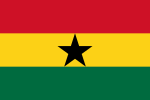Education in Ghana
 |
|
| Budget | 23% of government expenditure |
|---|---|
| Primary languages | English |
| System type | National |
| Total | 71.5 |
| Male | 78.3 |
| Female | 65.3 |
| Total | 8,329,177 |
| Primary | Pre-primary: 1,604,505, Primary: 4,105,913, JHS: 1,452,585 |
| Secondary | SHS and TVI: 904,212 |
| Post secondary | 261,962 (including universities: 109,278)‡ |
Education in Ghana was mainly informal, and based on apprenticeship before the arrival of European settlers, who built a formal education system addressed to the elites. With the independence of Ghana in 1957, universal education became an important political objective. The magnitude of the task as well as economic difficulties and political instabilities have slowed down attempted reforms. The Education Act in 1987, followed by the Constitution of 1992, gave a new impulse to educational policies in the country. In 2011, the primary school net enrollment rate was 84%, described by UNICEF as "far ahead" of the Sub-Saharan average. In its 2013-14 report, the World Economic Forum ranked Ghana 46th out of 148 countries for education system quality. In 2010, Ghana's literacy rate was 71.5%, with a notable gap between men (78.3%) and women (65.3%). Theguardian newspaper disclosed in April 2015 that 90% of children in Ghana were enrolled in school, ahead of countries like Pakistan and Nigeria at 72% and 64% respectively.
Education indicators in Ghana reflect a gender gap and disparities between rural and urban areas, as well as between southern and northern parts of the country. Those disparities drive public action against illiteracy and inequities in access to education. Eliminating illiteracy has been a constant objective of Ghanaian education policies for the last 40 years; the difficulties around ensuring equitable access to education is likewise acknowledged by the authorities. Public action in both domains has yielded results judged significant but not sufficient by national experts and international organizations. Increasing the place of vocational education and training and of ICT (information and communications technology) within the education system are other clear objectives of Ghanaian policies in education. The impact of public action remains hard to assess in these fields due to recent implementation or lack of data.
The Ministry of Education is responsible for the administration and the coordination of public action regarding Education. Its multiple agencies handle the concrete implementation of policies, in cooperation with the local authorities (10 regional and 138 district offices). The State also manages the training of teachers. Many private and public colleges prepare applicants to pass the teacher certification exam to teach at the primary level. Two universities offer special curricula leading to secondary education teacher certification. Education represented 23% of the state expenditure in 2010; international donor support to the sector has steadily declined as the State has taken on the bulk of education funding.
...
Wikipedia
